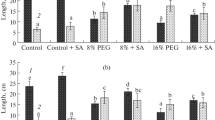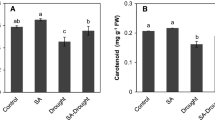Abstract
Salicylic acid (SA) acts as an endogenous signal molecule responsible for inducing abiotic stress tolerance in plants. In this study, the role of SA in improving drought tolerance in two maize cultivars (Zea mays L.) differing in their tolerance to drought was evaluated. The plants were regularly watered per pot and grown until the grain filling stage (R2) under a rainout shelter. At stage R2, parts of the plants were treated with SA, after which drought stress was applied. Leaf samples were harvested on the 10th and 17th days of the drought. Some antioxidant enzyme activity, such as the superoxide dismutase (SOD), catalase (CAT), ascorbate peroxidase (APX), glutathione reductase (GR), monodehydroascorbate reductase (MDHAR), dehydroascorbate reductase (DHAR), hydrogen peroxide (H2O2) and malondialdehyde (MDA) content, was measured during the drought period. Exogenous SA prevented water loss and delayed leaf rolling in comparison with control leaves in both cultivars. As a consequence of drought stress, lipid peroxidation, measured in terms of malondialdehyde content, was prevented by SA. SA pretreatment induced all antioxidant enzyme activities, and to a greater extent than the control leaves, during drought. SA also caused a reduction in the ascorbate (ASC) and glutathione (GSH) content in two maize cultivars. The H2O2 level was higher in SA pretreated plants than the controls in both cultivars. Pretreatment with SA further enhanced the activities of antioxidant enzymes and the concentrations of non-enzymatic antioxidants in the tolerant cultivar compared with the sensitive cultivar. Results suggested that exogenous SA could help reduce the adverse effects of drought stress and might have a key role in providing tolerance to stress by decreasing water loss and inducing the antioxidant system in plants with leaf rolling, an alternative drought protection mechanism.



Similar content being viewed by others
Abbreviations
- APX:
-
Ascorbate peroxidase
- ASC:
-
Ascorbic acid
- CAT:
-
Catalase
- DHA:
-
Dehydroascorbate
- DHAR:
-
Dehydroascorbate reductase
- g s :
-
Stomatal conductance
- GR:
-
Glutathione reductase
- GSH:
-
Reduced glutathione
- H2O2 :
-
Hydrogen peroxide
- MDA:
-
Malondialdehyde
- MDHAR:
-
Monodehydroascorbate reductase
- NBT:
-
Nitro blue tetrazolium
- ROS:
-
Reactive oxygen species
- RWC:
-
Relative water content
- SOD:
-
Superoxide dismutase
- Ψleaf :
-
Leaf water potential
References
Aebi H (1983) Catalase. In: Bergmeyer H (ed) Methods of enzymatic analysis. Weinheim-Verlag Chemie, Weinheim, pp 273–286
Agarwal S, Sairam RK, Srivastava GC, Meena RC (2005) Changes in antioxidant enzymes activity and oxidative stress by abscisic acid and salicylic acid in wheat genotypes. Biol Plantarum 49:541–550
Asada K (1999) The water–water cycle in chloroplasts: scavenging of active oxygens and dissipation of excess photons. Annu Rev Plant Physiol Plant Mol Biol 50:601–639
Bai J, Gong CM, Chen K, Kang HM, Wang G (2009) Examination of antioxidative system’s responses in the different phases of drought stress and during recovery in desert plant Reaumuria soongorica (Pall.) Maxim. J Plant Biol 52:417–425
Beauchamp C, Fridovich I (1971) Superoxide dismutase: improved assays and an assay applicable to acrylamide gels. Anal Biochem 44:276–287
Bezrukova MV, Sakhabutdinova R, Fathutdinova RA, Kyldiarova I, Shakirova F (2001) The role of hormonal changes in protective action of salicylic acid on growth of wheat seedlings under water deficit. Agrochemiya (Russ) 2:51–54
Bradford MM (1976) A rapid and sensitive method for the quantitation of microgram quantities of protein utilizing the principle of protein–dye binding. Anal Biochem 72:248–254
Contour-Ansel D, Torres-Franklin ML, Cruz H, de Carvalho M, D’arcy Lameta A, Zuily-Fodil Y (2006) Glutathione reductase in leaves of cowpea: cloning of two cDNAs, expression and enzymatic activity under progressive drought stress, desiccation and abscisic acid treatment. Ann Bot 98:1279–1287
Dat JF, Foyer CH, Scott IM (1998) Changes in salicylic acid and antioxidants during induction in thermotolerance in mustard seedlings. Plant Physiol 118:1455–1461
Dhindsa R, Matowe SW (1981) Drought tolerance in two mosses: correlated with enzymatic defence against lipid peroxidation. J Exp Bot 32:79–91
Downey LA (1971) Effect of gypsum and drought stress on maize (Zea mays L.). I. Growth, light absorption and yield. Agron J 63:569–572
El-Tayeb MA (2005) Response of barley grains to the interactive effect of salinity and salicylic acid. Plant Growth Regul 45:215–224
Farooq M, Aziz T, Hussain M, Rehman H, Jabran K, Khan MB (2008) Glycinebetaine improves chilling tolerance in hybrid maize. J Agron Crop Sci 194:152–160
Farooq M, Basra SMA, Wahid A, Ahmad N, Saleem BA (2009) Improving the drought tolerance in rice (Oryza sativa L.) by exogenous application of salicylic acid. J Agron Crop Sci 195:237–246
Farré I, Van Oijen M, Leffelaar PA, Faci JM (2000) Analysis of maize growth for different irrigation strategies in northeastern Spain. Eur J Agron 12:225–238
Foyer CH, Halliwell B (1976) Presence of glutathione and glutathione reductase in chloroplast: a proposed role in ascorbic acid metabolism. Planta 133:21–25
Griffith OW (1980) Determination of glutathione and glutathione disulfide using glutathione reductase and 2-vinylpyridine. Anal Biochem 106:207–212
Hayat S, Ahmad A (2007) Salicylic acid: a plant hormone. In: Janda T, Horvath E, Szalai G, Paldi E (eds) Role of salicylic acid in the induction of abiotic stress tolerance. Dordrecht, The Netherland, pp 91–150
Hayat S, Hasan SA, Fariduddin Q, Ahmad A (2008) Growth of tomato (Lycopersicon esculentum) in response to salicylic acid under water stress. J Plant Interact 3:297–304
Heath RL, Packer L (1968) Photoperoxidation in isolated chloroplasts. I. Kinetics and stoichiometry of fatty acid peroxidation. Arch Biochem Biophys 125:189–198
Hossain MA, Asada K (1984) Purification of dehydroascorbate reductase from spinach and its characterization as a thiol enzyme. Plant Cell Physiol 25:85–92
Hossain MA, Nakano Y, Asada K (1984) Monodehydroascorbate reductase in spinach chloroplasts and its participation in regeneration of ascorbate for scavenging hydrogen peroxide. Plant Cell Physiol 25:385–395
Hua YJ, Yuan GL, Man Y, Hua QX, Fang ZM (2008) Salicylic acid-induced enhancement of cold tolerance through activation of antioxidative capacity in watermelon. Sci Hortic 118:200–205
Hussain M, Malik MA, Farooq M, Khan MB, Akram M, Saleem MF (2009) Exogenous glycine betaine and salicylic acid application improves water relations, allometry, quality of hybrid sunflower under water deficit conditions. J Agron Crop Sci 195:98–109
Janda T, Szalai G, Tari T, Paldi E (1999) Hydroponic treatment with salicylic acid decreases the effects of chilling injury in maize (Zea mays L.) plants. Planta 208:175–180
Kadioglu A, Terzi R (2007) A dehydration avoidance mechanism: leaf rolling. Bot Rev 73:290–302
Kadioglu A, Saruhan N, Saglam A, Terzi R, Acet T (2011) Exogenous salicylic acid alleviates effects of long term drought stress and delays leaf rolling by inducing antioxidant system. Plant Growth Regul 64:27–37
Liso R, Innocenti AM, Bitonti MB, Arrigoni O (1984) Relationship between ascorbic acid and cell division. Exp Cell Res 150:314–320
Mishra A, Choudhuri MA (1999) Effects of salicylic acid on heavy metal-induced membrane deterioration mediated by lipoxygenase in rice. Biol Plantarum 42:409–415
Munne-Bosch S, Penuelas J (2003) Photo and antioxidative protection, and a role for salicylic acid during drought and recovery in field grown Phillyrea angustifolia plants. Planta 217:758–766
Nakano Y, Asada K (1981) Hydrogen peroxide is scavenged by ascorbate-specific peroxidase in spinach chloroplasts. Plant Cell Physiol 22:867–880
Premachandra GS, Saneoka H, Fujita K, Ogata S (1993) Water stress and potassium fertilization in field grown maize (Zea mays L.): effects of leaf water relations and leaf rolling. J Agron Crop Sci 170:195–201
Qui ZB, Liu X, Tian XJ, Yue M (2008) Effects of CO2 laser pretreatment on drought stress resistance in wheat. J Photochem Photobiol B 90:17–25
Rai VK, Sharma SS, Sharma S (1986) Reversal of ABA-induced stomatal closure by phenolic compounds. J Exp Bot 37:129–134
Rao MV, Paliyath G, Ormrod PD, Murr P, Watkins CB (1997) Influence of salicylic acid on H2O2 production, oxidative stress, and H2O2 metabolizing enzymes. Plant Physiol 115:137–149
Raskin I (1992) Role of salicylic acid in plants. Annu Rev Plant Physiol Plant Mol Biol 43:439–463
Sala JM, Lafuente MT (1999) Catalase in the heat-induced chilling tolerance of cold-stored hybrid Fortune mandarin fruits. J Agr Food Chem 47:2410–2414
Saruhan N, Terzi R, Saglam A, Kadioglu A (2010) Scavenging of reactive oxygen species in apoplastic and symplastic areas of rolled leaves in Ctenanthe setosa under drought stress. Acta Biol Hung 61:282–298
Senaratna T, McKersie BD, Stinson RH (1985) Stimulation of dehydration injury by free radicals. Plant Physiol 77:472–474
Senaratna T, Touvhell D, Bunn E, Dixon K (2000) Acetyl salicylic acid (aspirin) and salicylic acid induce multiple stress tolerance in bean and tomato plant. Plant Growth Regul 30:157–161
Shakirova FM, Sakhabutdinova AR, Bezrukova MV, Fakthutdinova RA, Fakthutdinova DR (2003) Changes in hormonal status of wheat seedlings induced by salicylic acid and salinity. Plant Sci 164:317–322
Shim IS, Momose Y, Yamamoto A, Kim DW, Usui K (2003) Inhibition of catalase activity by oxidative stress and its relationship to salicylic acid accumulation in plants. Plant Growth Regul 39:285–292
Smirnoff N (1998) Plant resistance to environmental stress. Curr Opin Biotech 9:214–219
Smirnoff N, Wheeler GL (2000) Ascorbic acid in plants: biosynthesis and function. Crit Rev Biochem Mol 35:291–314
Subashri M, Robin S, Vinod KK, Rajeswari S, Mohanasundaram K, Raveendran TS (2009) Trait identification and QTL validation for reproductive stage drought resistance in rice using selective genotyping of near flowering RILs. Euphytica 166:291–305
Taiz I, Zeiger E (2006) Plant physiology, 4th edn. Sinauer Associates Inc. Publishers, Sunderland, Massachusetts, p 764
Takahama U, Oniki T (1994) The association of ascorbate and ascorbate oxidase in the apoplast with IAA-enhanced elongation of epicotyls from Vigna angularis. Plant Cell Physiol 35:257–266
Velikova V, Yordanov I, Edreva A (2000) Oxidative stress and some antioxidant systems in acid rain-treated bean plants. Protective role of exogenous polyamines. Plant Sci 151:59–66
Wahid A, Parveen M, Gelani S, Basra A (2007) Pretreatment of seeds with H2O2 improves salt tolerance wheat seedling by alleviation of oxidative damage and expression of stress proteins. J Plant Physiol 164:283–294
Waseem M, Athar H, Ashraf M (2006) Effect of salicylic acid applied through rooting medium on drought tolerance of wheat. Pak J Bot 38:1127–1136
Zaidi PH, Yadav M, Singh DK, Singh RP (2008) Relationship between drought and excess moisture tolerance in tropical maize (Zea mays L.). Aust J Crop Sci 1:78–96
Zhu JK (2002) Salt and drought stress signal transduction in plants. Annu Rev Plant Biol 53:247–273
Acknowledgments
The authors are grateful to Tuba Acet (Gümüşhane University) for salicylic acid pretreatment and plant breeding.
Author information
Authors and Affiliations
Corresponding author
Additional information
Communicated by P. K. Nagar.
Rights and permissions
About this article
Cite this article
Saruhan, N., Saglam, A. & Kadioglu, A. Salicylic acid pretreatment induces drought tolerance and delays leaf rolling by inducing antioxidant systems in maize genotypes. Acta Physiol Plant 34, 97–106 (2012). https://doi.org/10.1007/s11738-011-0808-7
Received:
Revised:
Accepted:
Published:
Issue Date:
DOI: https://doi.org/10.1007/s11738-011-0808-7




